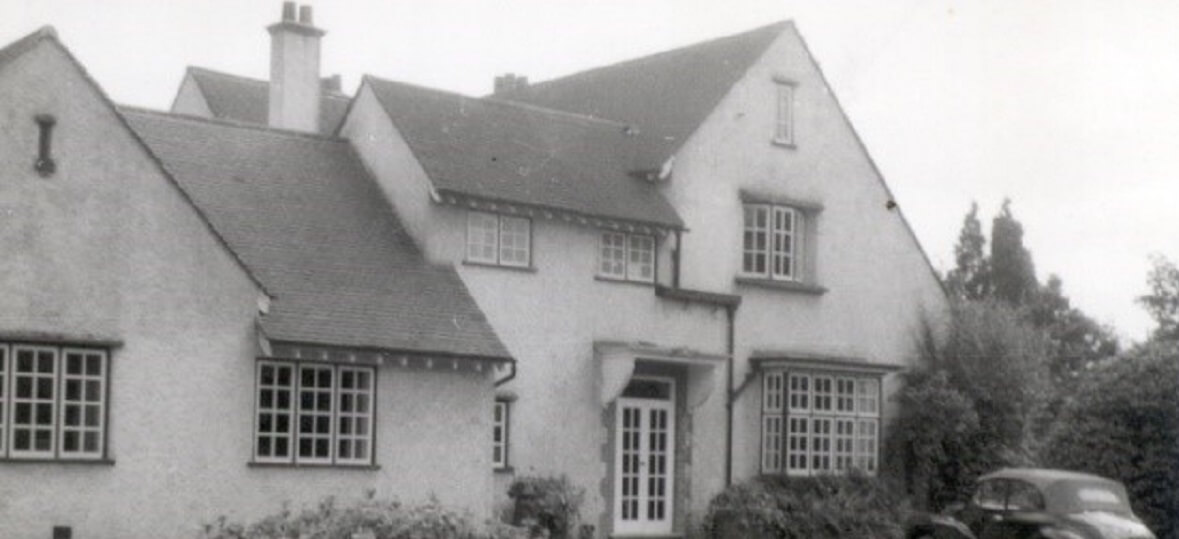By Alison Bailey
In 1912 John Simmons (1871-1943) moved to Amersham to live at Chilterns, a substantial country house, down a long drive off White Lion Road on Amersham Common. Age 41, he was a well-travelled, cultured batchelor. He was also independently wealthy, as the family business he had worked in had just been sold. This meant he could now devote himself fulltime to painting which was his passion and for which he had a genuine talent.
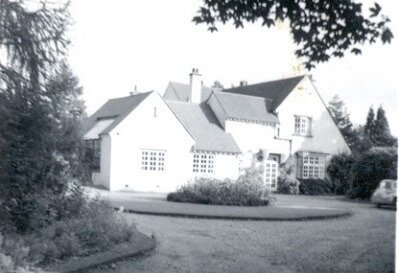
Chilterns had been the weekend home of his older sister, Jane. She built the house in a large country estate of around 16 acres with her husband Dr Bertram Abrahams and had kept it on after her husband’s tragically early death in 1908. Four years later, Jane was also dead, and the property was inherited by their only child, Margery who was just 14. As Margery’s guardian, John made Chilterns his principal residence so that could provide his niece with a secure home, whilst she completed her education.
John built himself a large artist’s studio at Chilterns. This later became an important cultural hub for the Amersham community and was used to host music concerts, plays and lectures.
The Simmons Family
John was born in 1871 to a prosperous middle-class family. He had one older sister, Jane, age 3, and the family was living in some style in a Georgian house at 41 Gordon Square. Both parents, Abraham John Simmons and Rachael Salaman were from Jewish families who had lived in Britain for many generations. His father (also known as John) established a successful theatrical costumiers, in Piccadilly, A J Simmons, which later became the fashion house, “Ladies’ Tailors and Court Dressmakers”, John Simmons & Sons.

John joined the family firm in 1885 when he was just 14. Whilst his artistic talent was already evident, he was expected to continue the family business and enjoy his art as a hobby rather than a career. John and the business prospered, and he took every opportunity to travel, particularly to France, North Africa and even Poland and Norway. He enjoyed a wide circle of academic and business friends, including André Keim, his French supplier of specialist buttons and buckles. Many years later Keim was piloting a 4-seater de Havilland plane to visit John in Amersham when it clipped overhead wires whilst trying to land in a field in Stanley Hill. One of the passengers was killed in the crash and Keim suffered a serious injured.
In late 1912, John senior retired, and the business was sold. John junior was now able to live the comfortable life of a gentleman and devote more time to travel and his art, and to the education of his niece. Perhaps rather surprisingly John joined the special constabulary in Portsmouth for the duration of WWI.
John Simmons the artist
It is understood that John attended art courses at the Slade where he was taught by Walter Sickert, who he knew as Richard, Sickert’s middle-name, and the name he wished to be known by at the time. The Slade have no record of his attending but as he never enrolled for a degree course and only attended part-time this is to be expected. Sickert’s style was a major influence on John’s work although he was also influenced by the works of Cezanne and Seurat. His technique, which he never greatly altered, was consistent with Slade artists from the beginning of the 20th century. He was an acquaintance of Augustus John, who trained at the Slade and sketched his uncle. He made lifelong friends with other artists, including Samuel Birch, known as Lamorna Birch, (who lived and painted at Lamorna Cove in Cornwall) and Freda Marston and Reginald St Clair Marston, both landscape painters and etchers.
John’s desire to paint was the perfect excuse to travel and he took month long painting trips to many countries, returning often to some, particularly France and Italy. But he also travelled to Egypt, Turkey and Serbia. Whilst travelling John painted small oil sketches on panels that he then worked up into larger paintings at home in his studio.

Between 1925 and 1940 John exhibited at several important galleries including the Goupil Gallery in London, the New English Art Club, the Royal Society of Portrait Painters, Royal Academy of Arts, Royal Society of British Artists, Royal Institute of Oil Painters and the Walker Art Gallery in Liverpool. Today, Museums Sheffield has an example of his work, Sheffield Fair where the bright lights of fairground stalls contrast with the dim, smoggy townscape of Sheffield.
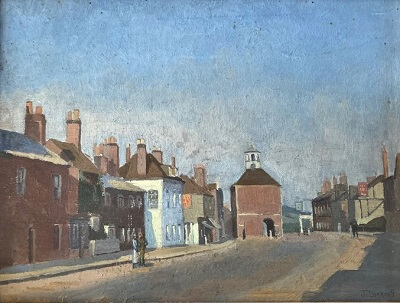
However, from 1920 John was regularly exhibiting in Amersham and the surrounding area after becoming a founding member of the Buckinghamshire Art Society whose president was the celebrity Victorian portrait painter, Louise Jopling. He also exhibited at the inaugural exhibition of Louise Jopling’s Chiltern Club of Arts in Aylesbury in 1920 with Percy Bigland, Mary Henrietta Dering Curtois, Car Richardson, and Alexander Jamieson.
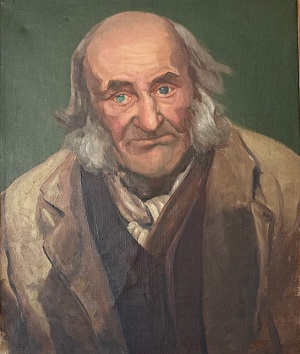
In 1933 the Bucks Art Society exhibited 90 of John’s paintings in a one man show at the Griffin Art Gallery. The first floor of the Griffin Hotel had become the society’s permanent gallery after holding regular exhibitions in the Amersham Market Hall and around the county. A review in the local press particularly praised the paintings In My Studio, Amersham Fair and The Late Mr Domer Gladman. Previous one man shows had been held in 1933 by Fred Stubbings of Coleshill, John Lomer Thirtle of Uxbridge, and Max Hofler of Harrow. John was chairman of the Bucks Art Society by 1933, a position he held for many years.
A late marriage
In 1930, John married Dr Margery Freeborough, from Sheffield, who was 23 years younger than her husband and much closer in age to his niece, Margery Abrahams, who may even have introduced them. Before the wedding Margery Freeborough was working as a specialist in Radiology in Harley Street. The Sheffield Daily Telegraph reported on the wedding under the headline “Career Sacrificed”! The bride’s father was quoted as saying, “she will now give up [her occupation], as she regards marriage as a whole time job”. Margery was educated at Sheffield County School and Royal Holloway College before taking her medical degree at University College London. The same article described her as a “petite dark girl with a vivacious manner”. Margery’s father was an accountant, magistrate, and Methodist by faith.
John and Margery built a new house in the grounds of Chilterns, New Chilterns, approached down a long lime tree lined drive (originally Chiltern Drive, but now Lime Tree Walk). They had two children here, Rachel, born in 1931 and John, born in 1932. Rachel went to Cambridge before working as an archaeologist in Greece where she met her husband, Sinclair Hood, the then Director of the British School of Archaeology in Athens. Their wedding reception was held at New Chilterns in 1957.
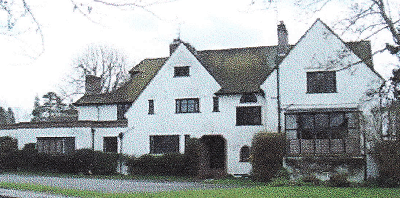
A Haven on Amersham Common
As National Socialism gained power in Germany the family’s sympathies were aroused by the plight of the Jews in Germany. John Simmons formed the Chesham, Amersham and District Refugee Fund Committee with other influential local residents. These included several vicars, such as Reverand C E Briggs of St Marys, Amersham, Dr Sibyl Welsh, living at Hyde Heath and Lady Olive Astley Cubbitt, the founder of The Lady Cubitt Compassionate Association in Bermuda (where her husband had been governor) of Bendrose Grange, Amersham Common. In their 1939 June report, they were supporting 12 people, mainly from Vienna, in two rented houses in Ashley Green and Chesham at a cost of £6 per week. The committee was asking for financial support and offers of private hospitality as they had been approached by the British Committee for Refugees from Czechoslovakia and other organisations for assistance. The Simmons family also welcomed refugees and evacuees into their home during WWII.
John died in 1943 and is buried in the Platt, Old Amersham. Margery Simmons outlived him by nearly 40 years. After her death in 1980 she was also buried in the Platt.
Sources
John Simmons (1871-1943): Artist by Alexander Simmons, History of Art Dissertation
Dictynna Hood, John Simmons’ granddaughter
Ancestry.com
British Newspaper Archive
New Chilterns by John Simmons, son of John Simmons the artist
eMuseum (museums-sheffield.org.uk)
SIMMONS John 1871-1943 | Artist Biographies (artbiogs.co.uk)
Alexander-Jamieson-final.pdf (bucksgardenstrust.org.uk)
Amersham in the last 100 Years Exhibition file, letter dated 26 January 2005 from David Tench, and a summary of interviews with Margery Abrahams in 1977 and 1979, Amersham Museum collection

